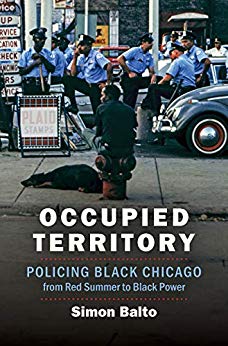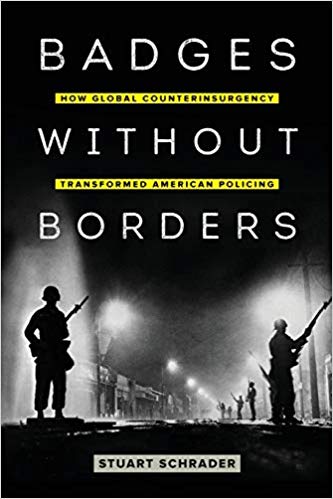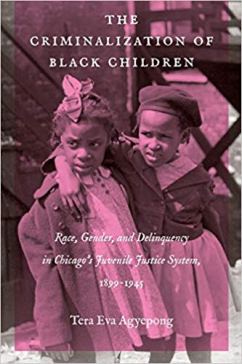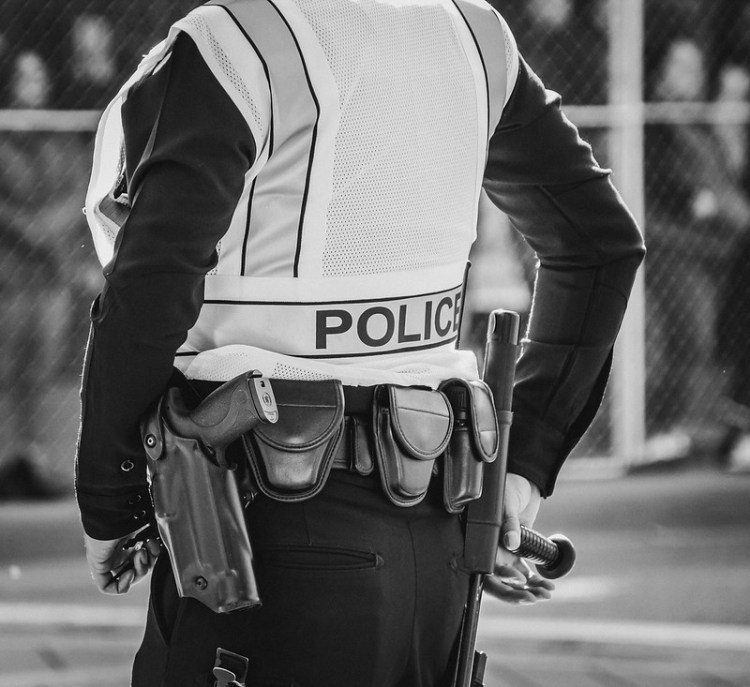By Matt Guariglia and Charlotte Rosen
This week, the United Nations released a human rights report that the massive protests rocking cities across the globe are — surprise — rooted in the massive and deeply-rooted inequalities that continue to divide societies and test the legitimacy of governments. With this current rising tide of global protests also comes the very visible show of force from regimes. New technology like face recognition, drones, and the expansion of twenty-first century military technology on the home front has meant protestors have needed to get creative and states have been very publicly removing the supposed velvet glove from the iron fist.
For an increasing number of historians and social scientists, state-sanctioned shows of force along racial, class, political, immigration status, and gendered lines have a deeper history. While being wielded in new and powerful ways, efforts by states to police borders, crush dissent, and terrorize racially and economically marginalized communities are far from new. Building off of the incredible amount of scholarship from 2018, and reflecting the urgency of our times, carceral studies and the fields of the history of incarceration, policing, state violence, and immigration enforcement continued to grow at an exponential rate.
 In 2019, UNC Press’s Justice, Power, and Politics series continued to expand the reach of carceral studies by publishing Max Felker-Kantor’s Policing Los Angeles: Race Resistance, and the Rise of the LAPD, and Simon Balto’s Occupied Territory: Policing Black Chicago from Red Summer to Black Power. Starting in the 1960s, Felker-Kantor’s book traces the interconnectedness of racial capitalism, resistance, and the expansion of police power through politics and the mobilization of fear in the United States’ second largest city. Compellingly written and deeply researched, his book makes that case that Los Angeles truly provides a unique test case for those invested in the history of state power. To contend with “concerns around youth violence, the militarized war on gangs and drugs, the surveillance of social movements, and the response to new waves of immigrants,” the LAPD became the U.S., and the world’s, laboratory for new policing tactics. Critically, he shows that the police were not an institution that merely absorbed resources or directives from politicians, but rather that police were active and powerful participants in advocating for the harmful expansion of police power and authority in ways that entrenched white supremacy in systems of metropolitan governance.
In 2019, UNC Press’s Justice, Power, and Politics series continued to expand the reach of carceral studies by publishing Max Felker-Kantor’s Policing Los Angeles: Race Resistance, and the Rise of the LAPD, and Simon Balto’s Occupied Territory: Policing Black Chicago from Red Summer to Black Power. Starting in the 1960s, Felker-Kantor’s book traces the interconnectedness of racial capitalism, resistance, and the expansion of police power through politics and the mobilization of fear in the United States’ second largest city. Compellingly written and deeply researched, his book makes that case that Los Angeles truly provides a unique test case for those invested in the history of state power. To contend with “concerns around youth violence, the militarized war on gangs and drugs, the surveillance of social movements, and the response to new waves of immigrants,” the LAPD became the U.S., and the world’s, laboratory for new policing tactics. Critically, he shows that the police were not an institution that merely absorbed resources or directives from politicians, but rather that police were active and powerful participants in advocating for the harmful expansion of police power and authority in ways that entrenched white supremacy in systems of metropolitan governance.
 As a companion, Balto’s work further emphasizes the geographic rootedness of the history of policing. By starting in the aftermath of the Chicago riot of 1919, Balto is able to provide earlier context than most pieces of postwar scholarship, demonstrating a history of institutionalized racist police repression that predated the Wars on Crime and Drugs. He dismantles the myth of a “golden age” of nonracist policing by detailing at length how the policing of Black Chicagoans, like the U.S. state itself, expanded in size and capacity as early as Prohibition and the Great Depression. He importantly highlights the cruel contradiction of policing in Black Chicago, as in other cities across the nation in the postwar period: Black Chicagoans were both “overpoliced and underprotected.” Within a context where Black Chicagoans were already massively underserved by the city, these long-entrenched patterns of racist policing were ultimately what allowed racialized mass criminalization to develop “so suddenly as a full blown instrument of racial repression.”
As a companion, Balto’s work further emphasizes the geographic rootedness of the history of policing. By starting in the aftermath of the Chicago riot of 1919, Balto is able to provide earlier context than most pieces of postwar scholarship, demonstrating a history of institutionalized racist police repression that predated the Wars on Crime and Drugs. He dismantles the myth of a “golden age” of nonracist policing by detailing at length how the policing of Black Chicagoans, like the U.S. state itself, expanded in size and capacity as early as Prohibition and the Great Depression. He importantly highlights the cruel contradiction of policing in Black Chicago, as in other cities across the nation in the postwar period: Black Chicagoans were both “overpoliced and underprotected.” Within a context where Black Chicagoans were already massively underserved by the city, these long-entrenched patterns of racist policing were ultimately what allowed racialized mass criminalization to develop “so suddenly as a full blown instrument of racial repression.”
 The series also gave us Robert Chase’s edited volume, Caging Borders and Carceral States: Incarcerations, Immigration Detentions, and Resistance, a key volume about “crimmigration” in the American South and West with chapters by scholars Dan Berger, Kelly Lytle Hernández, Talitha L. LeFlouria, and Donna Murch, to name just a few. The collection examines how an analysis of the carceral state which explores the manner in which states coerce, surveill, and cage both citizens and migrants alike can sharpen our understanding of not just regimes of punishment but also sovereignty and citizenship. This volume also offers examples of how imprisoned people and migrants resisted state violence and challenged the very carceral, colonial, and racialized logics embedded in the nation state itself.
The series also gave us Robert Chase’s edited volume, Caging Borders and Carceral States: Incarcerations, Immigration Detentions, and Resistance, a key volume about “crimmigration” in the American South and West with chapters by scholars Dan Berger, Kelly Lytle Hernández, Talitha L. LeFlouria, and Donna Murch, to name just a few. The collection examines how an analysis of the carceral state which explores the manner in which states coerce, surveill, and cage both citizens and migrants alike can sharpen our understanding of not just regimes of punishment but also sovereignty and citizenship. This volume also offers examples of how imprisoned people and migrants resisted state violence and challenged the very carceral, colonial, and racialized logics embedded in the nation state itself.
In addition to Chicago and Los Angeles, policing and resistance in New York City also recieved deep exploration. Carl Suddler’s book Presumed Criminal: Black Youth and the Justice System in Postwar New York picked up where Tera Eva Agyepong’s 2018 book, The Criminalization of Black Children: Race, Gender, and Delinquency in Chicago’s Juvenile Justice System, 1899-1945, left off. By analyzing racialization and the presumed criminality of Black youth in New York, Suddler’s book smartly illustrates the enmeshed processes of race-making and crime-making in the eyes of New York’s “hard on crime” justice system. That system, however, has never gone unopposed. So says Clarence Taylor’s 2019 book, Fight the Power: African Americans and the Long History of Police Brutality in New York. Beginning in the 1940s, the book demonstrates how reformist rhetoric, electoral politics, a thriving Black press, and protests all became important avenues for voicing opposition to police brutality.

Like people, ideas, and goods, police, policing tactics, and police authority has always been mobile. Stuart Schrader’s excellent Badges Without Borders: How Global Counterinsurgency Transformed American Policing takes the field into the vital realm of considering American policing as part of a shared global endeavor of international governments to subordinate their racialized, activist, and working classes. Starting in the early Cold War, Schrader reveals new dimensions of the long history of the American empire by showing how organizations like the Office of Public Safety brought American-style policing to exert forceful control over Cold War battleground nations, and how this expanded colonial influence ended up back on the streets of American cities in the form of S.W.A.T. teams and other militarized counter-insurgency tactics. Marisol LeBrón’s brilliant Policing Life and Death: Race, Violence, and Resistance in Puerto Rico also traces the impact of American imperialist impulses on the rise of modern policing. In the first monograph of its kind, LeBrón shows how colonial state building, colonial subject making, and punitive state violence become entwined while people on the ground were still able to create space for organizing and resistance.

Commonly associated with freedom, the movement of people on American highways actually put them more squarely under the authority and watchful eye of police. More than on urban streets or in quiet rural towns, the open road presents an uncontested space where police can patrol, survey, and detain people at will. Sarah A. Seo’s groundbreaking Policing the Open Road: How Cars Transformed American Freedom, published in 2019, offers a novel and compelling new approach to considering how movement, the physical space and technology of the car, and an evolving legal system impacted American policing.
Moving across borders has also made subjects specifically vulnerable to the oversized impact of the U.S. state. Recent books about the history of the state’s ability to classify, record, and survey immigrants provide our present moment of deportation and caging with needed context. The rise of the United States’ brutal deportation and detention regime emerged in tandem with the states’ ability to disseminate xenophobic rhetoric, collect information on individuals, and make that information actionable. For that reason, recent books by Joel Pearlman, Katherine Benton-Cohen, Beth Lew-Williams, and Erika Lee, and the forthcoming book by Julia Rose Kraut, all make clear how entwined racial gatekeeping is to the carceral state.
2019 also provided a number of opportunities for historians to explore the historical roots of contemporary issues surrounding incarceration, policing, and state violence in formats beyond the monograph. In the Journal of American History, Anne Gray Fischer published “‘Land of the White Hunter’: Legal Liberalism and the Racial Politics of Morals Enforcement in Midcentury Los Angeles,” which highlights the inextricably gendered dimension of postwar racialized policing regimes. While morals policing has historically been a site of racialized and gendered oppression, Gray Fischer details how a rise of sexual liberalism and attendant legal liberalism in morals enforcement in the postwar period widened the racial inequity in morals policing and specifically encouraged the sexual policing of Black women. This dynamic helped catalyze the multitude of conflicts between Black residents and police during this period and served as an under-discussed factor in the lead-up to the 1965 Watts Uprising. In another piece that is sure to influence studies of both the carceral state and metropolitan politics, Gray Fischer’s “‘The Place is Gone!’: Policing Black Women to Redevelop Downtown Boston,” published in the Journal of Social History, details the history of sexual policing and gentrification in Boston. She shows how Boston’s politicians and urban planners worked hand in hand with the police to criminalize and spatially displace Black women as a means of redeveloping Boston’s downtown. Amanda Hughett’s article, “A “Safe Outlet” for Prisoner Discontent: How Prison Grievance Procedures Helped Stymie Prison Organizing During the 1970s,” published by Law & Social Inquiry, furthered the conversation about the unintentionally harmful outcomes of prison reform litigation. She describes how civil liberties lawyers in 1970s North Carolina unintentionally helped provide state’s attorneys with tools to crush prisoner organizing by developing prisoner grievance procedures that the state used to legally ban prison organizing.
The Washington Post’s Made by History blog continued to be a vital home for disseminating historical scholarship on policing and prisons. In the wake of the news that the LAPD was running recruitment ads on the right-wing website Breitbart, Max Felker-Kantor wrote about the deep conservative currents within the department. As the doors to the NYPD’s museum continue to remain shuttered, Matthew Guariglia took the opportunity to reflect on police departments’ use of public history to spread official narratives of state violence, and how a lack of access to archival materials hurts historians. In honor of the release of Ava DuVernay’s “When They See Us,” about the unjust incarceration of the Central Park 5, both Carl Suddler and Anne Gray Fischer discussed thet inequities in the justice system and carceral feminisms within the case. Dan Berger also continued to infuse critical historical analyses of the carceral state into contemporary conversations about mass incarceration in his frequent work for Truthout.org, such as in his recent piece that considers how to make sense of rising numbers of incarcerated white people while still retaining an analysis of prisons that centers around their inherent racism.

History conferences organized around all major time periods, subject matter, and geographic areas have had to open up more and more space for people to understand the deep genealogies of state power. In early December, the University of Mississippi hosted a game-shifting conference (organized by historian Garret Felber, whose book Those Who Know Don’t Say: The Nation of Islam, the Black Freedom Movement, and the Carceral State will be one of the first out in 2020!) that brought together scholars and activists from dozens of spaces and fields to explore “Making and Unmaking Mass Incarceration.” MUMI will hopefully be only the first of many public conferences that bring together scholars, activists, and students to explore all of the incredible work being done to historically contextualize and imagine the future of police and prison abolition movements (and you can read a fantastic overview of the conference by Micah Herskind here).
2020 brings a new decade and dozens of forthcoming books, articles, podcasts, and conferences about resistance and the carceral state. In an increasingly globalized world, where police can share tear gas canisters as easily as protestors can tweet videos, it is more important than ever to keep our scholarly eyes on the interconnectedness that both aids and sometimes hinders solidarity, resistance, and the shared intellectual and technological vectors of racialized and colonial state violence. In addition to keeping the scholarly scope of the field open, it’s also vital that the field remains open, hospitable, and supportive to those producing work from positions of contingency or from outside the academy altogether. Increasingly, the innovative and new work that allows this field to flourish and grow is coming from people working beyond the traditional tenure track and who are, importantly, connected to larger social movements that aim to end policing, abolish prisons, and transform our society’s relationship to harm. If we want to continue to excavate the past of our dire present, it is vital that room, attention, and resources be dedicated to their work.
Featured photo (at top): LAPD on Hollywood Blvd, Jim Donaway, February 24, 2019 courtesy of flickr.com





3 thoughts on “Disciplining the City Review Essay 2019”